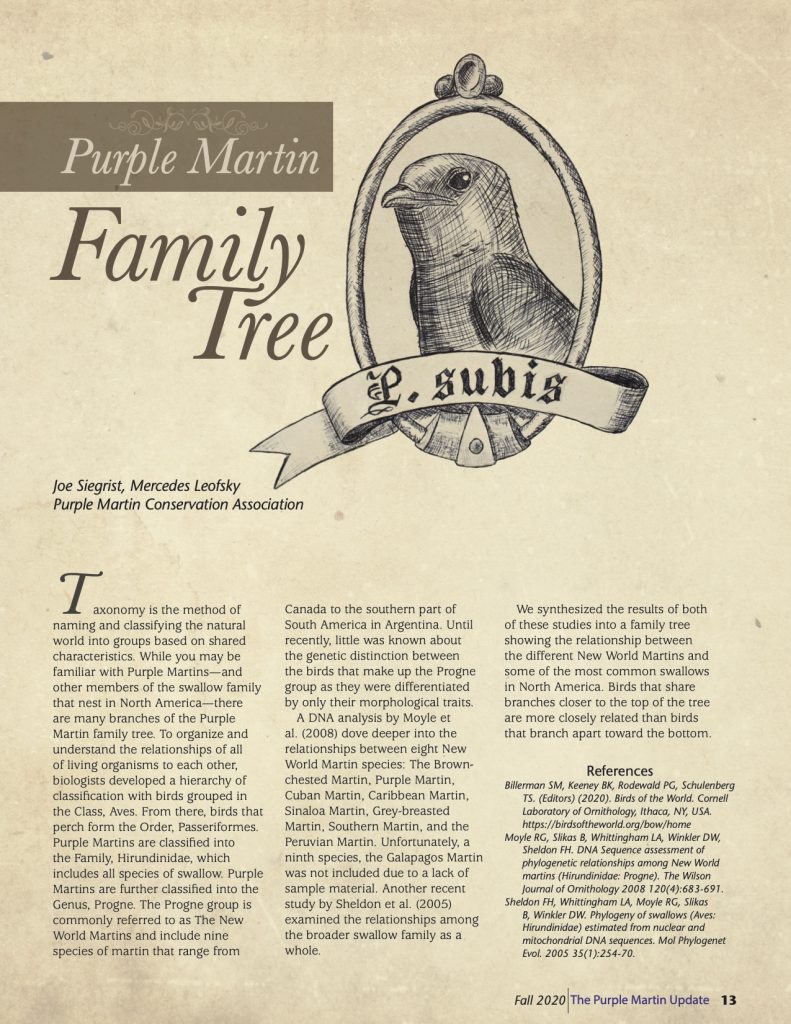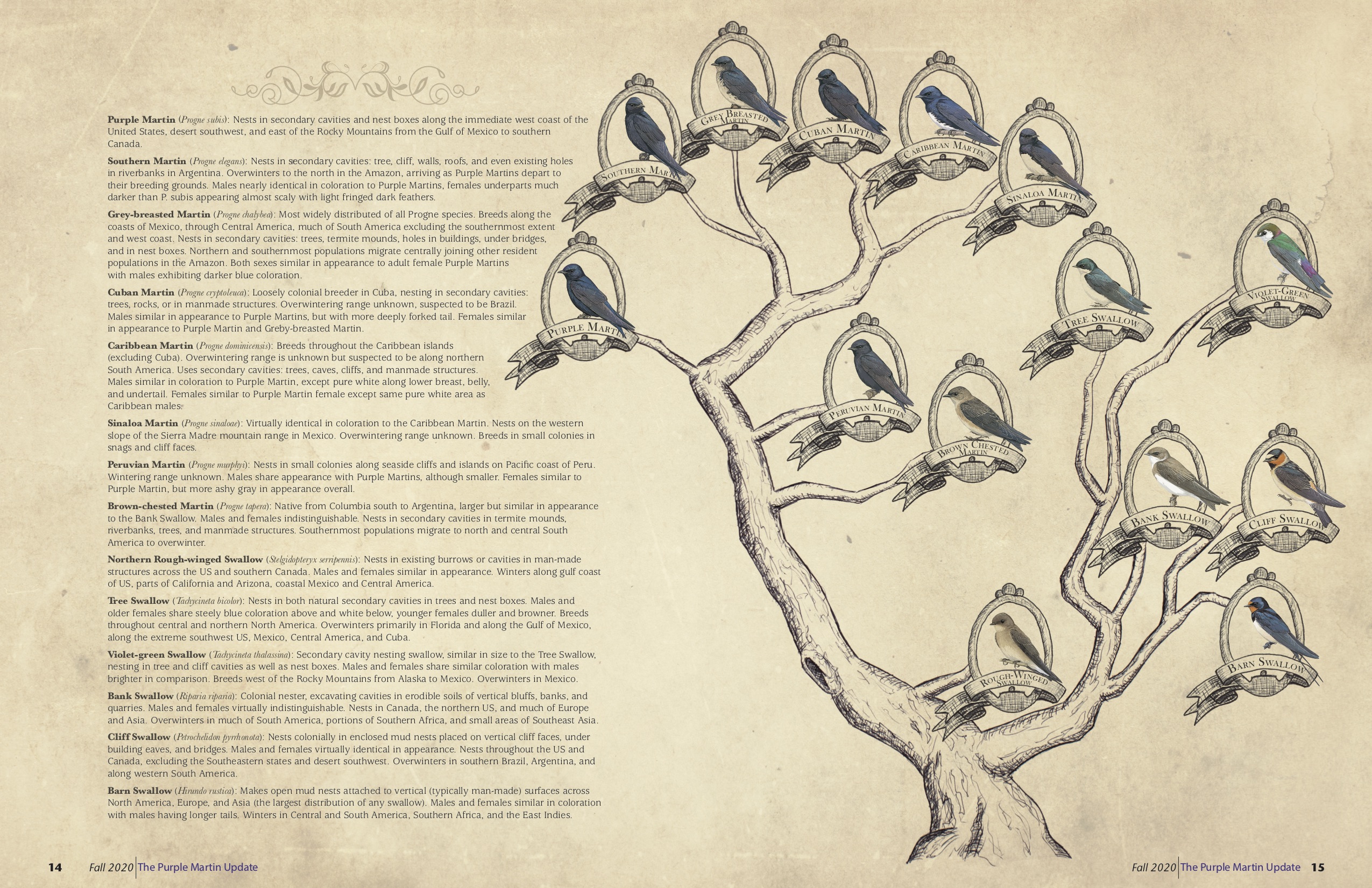Taxonomy is the method of naming and classifying the natural world into groups based on shared characteristics. While you may be familiar with Purple Martins—and other members of the swallow family that nest in North America—there are many branches of the Purple Martin family tree. To organize and understand the relationships of all of living organisms to each other, biologists developed a hierarchy of classification with birds grouped in the Class, Aves. From there, birds that perch form the Order, Passeriformes. Purple Martins are classified into the Family, Hirundinidae, which includes all species of swallow. Purple Martins are further classified into the Genus, Progne. The Progne group is commonly referred to as The New World Martins and include nine species of martin that range from Canada to the southern part of South America in Argentina. Until recently, little was known about the genetic distinction between the birds that make up the Progne group as they were differentiated by only their morphological traits.
A DNA analysis by Moyle et al. (2008) dove deeper into the relationships between eight New World Martin species: The Brown-chested Martin, Purple Martin, Cuban Martin, Caribbean Martin, Sinaloa Martin, Grey-breasted Martin, Southern Martin, and the Peruvian Martin. Unfortunately, a ninth species, the Galapagos Martin was not included due to a lack of sample material. Another recent study by Sheldon et al. (2005) examined the relationships among the broader swallow family as a whole.
We synthesized the results of both of these studies into a family tree showing the relationship between the different New World Martins and some of the most common swallows in North America. Birds that share branches closer to the top of the tree are more closely related than birds that branch apart toward the bottom.


Purple Martin (Progne subis): Nests in secondary cavities and nest boxes along the immediate west coast of the United States, desert southwest, and east of the Rocky Mountains from the Gulf of Mexico to southern Canada.
Southern Martin (Progne elegans): Nests in secondary cavities: tree, cliff, walls, roofs, and even existing holes in riverbanks in Argentina. Overwinters to the north in the Amazon, arriving as Purple Martins depart to their breeding grounds. Males nearly identical in coloration to Purple Martins, females underparts much darker than P. subis appearing almost scaly with light fringed dark feathers.
Grey-breasted Martin (Progne chalybea): Most widely distributed of all Progne species. Breeds along the coasts of Mexico, through Central America, much of South America excluding the southernmost extent and west coast. Nests in secondary cavities: trees, termite mounds, holes in buildings, under bridges, and in nest boxes. Northern and southernmost populations migrate centrally joining other resident populations in the Amazon. Both sexes similar in appearance to adult female Purple Martins with males exhibiting darker blue coloration.
Cuban Martin (Progne cryptoleuca): Loosely colonial breeder in Cuba, nesting in secondary cavities: trees, rocks, or in manmade structures. Overwintering range unknown, suspected to be Brazil. Males similar in appearance to Purple Martins, but with more deeply forked tail. Females similar in appearance to Purple Martin and Greby-breasted Martin.
Caribbean Martin (Progne dominicensis): Breeds throughout the Caribbean islands (excluding Cuba). Overwintering range is unknown but suspected to be along northern South America. Uses secondary cavities: trees, caves, cliffs, and manmade structures. Males similar in coloration to Purple Martin, except pure white along lower breast, belly, and undertail. Females similar to Purple Martin female except same pure white area as males.
Sinaloa Martin (Progne sinaloae): Virtually identical in coloration to the Caribbean Martin. Nests on the western slope of the Sierra Madre mountain range in Mexico. Overwintering range unknown. Breeds in small colonies in snags and cliff faces.
Peruvian Martin (Progne murphyi): Nests in small colonies along seaside cliffs and islands on Pacific coast of Peru. Wintering range unknown. Males share appearance with Purple Martins, although smaller. Females similar to Purple Martin, but more ashy gray in appearance overall.
Brown-chested Martin (Progne tapera): Native from Columbia south to Argentina, larger but similar in appearance to the Bank Swallow. Males and females indistinguishable. Nests in secondary cavities in termite mounds, riverbanks, trees, and manmade structures. Southernmost populations migrate to north and central South America to overwinter.
Northern Rough-winged Swallow (Stelgidopteryx serripennis): Nests in existing burrows or cavities in man-made structures across the US and southern Canada. Males and females similar in appearance. Winters along gulf coast of US, parts of California and Arizona, coastal Mexico and Central America.
Tree Swallow (Tachycineta bicolor): Nests in both natural secondary cavities in trees and nest boxes. Males and older females share steely blue coloration above and white below, younger females duller and browner. Breeds throughout central and northern North America. Overwinters primarily in Florida and along the Gulf of Mexico, along the extreme southwest US, Mexico, Central America, and Cuba.
Violet-green Swallow (Tachycineta thalassina): Secondary cavity nesting swallow, similar in size to the Tree Swallow, nesting in tree and cliff cavities as well as nest boxes. Males and females share similar coloration with males brighter in comparison. Breeds west of the Rocky Mountains from Alaska to Mexico. Overwinters in Mexico.
Bank Swallow (Riparia riparia): Colonial nester, excavating cavities in erodible soils of vertical bluffs, banks, and quarries. Males and females virtually indistinguishable. Nests in Canada, the northern US, and much of Europe and Asia. Overwinters in much of South America, portions of Southern Africa, and small areas of Southeast Asia.
American Cliff Swallow (Petrochelidon pyrrhonota): Nests colonially in enclosed mud nests placed on vertical cliff faces, under building eaves, and bridges. Males and females virtually identical in appearance. Nests throughout the US and Canada, excluding the Southeastern states and desert southwest. Overwinters in southern Brazil, Argentina, and along western South America.
Barn swallow (Hirundo rustica): Makes open mud nests attached to vertical (typically man-made) surfaces across North America, Europe, and Asia (the largest distribution of any swallow). Males and females similar in coloration with males having longer tails. Winters in Central and South America, Southern Africa, and the East Indies.
Joe Seigrist, Mercedes Leofsky
PMCA
Join or Renew today and never miss an issue of The Purple Martin Update.
Billerman SM, Keeney BK, Rodewald PG, Schulenberg TS. (Editors) (2020). Birds of the World. Cornell Laboratory of Ornithology, Ithaca, NY, USA. https://birdsoftheworld.org/bow/home
Moyle RG, Slikas B, Whittingham LA, Winkler DW, Sheldon FH. DNA Sequence assessment of phylogenetic relationships among New World martins (Hirundinidae: Progne). The Wilson Journal of Ornithology 2008 120(4):683-691.
Sheldon FH, Whittingham LA, Moyle RG, Slikas B, Winkler DW. Phylogeny of swallows (Aves: Hirundinidae) estimated from nuclear and mitochondrial DNA sequences. Mol Phylogenet Evol. 2005 35(1):254-70.
